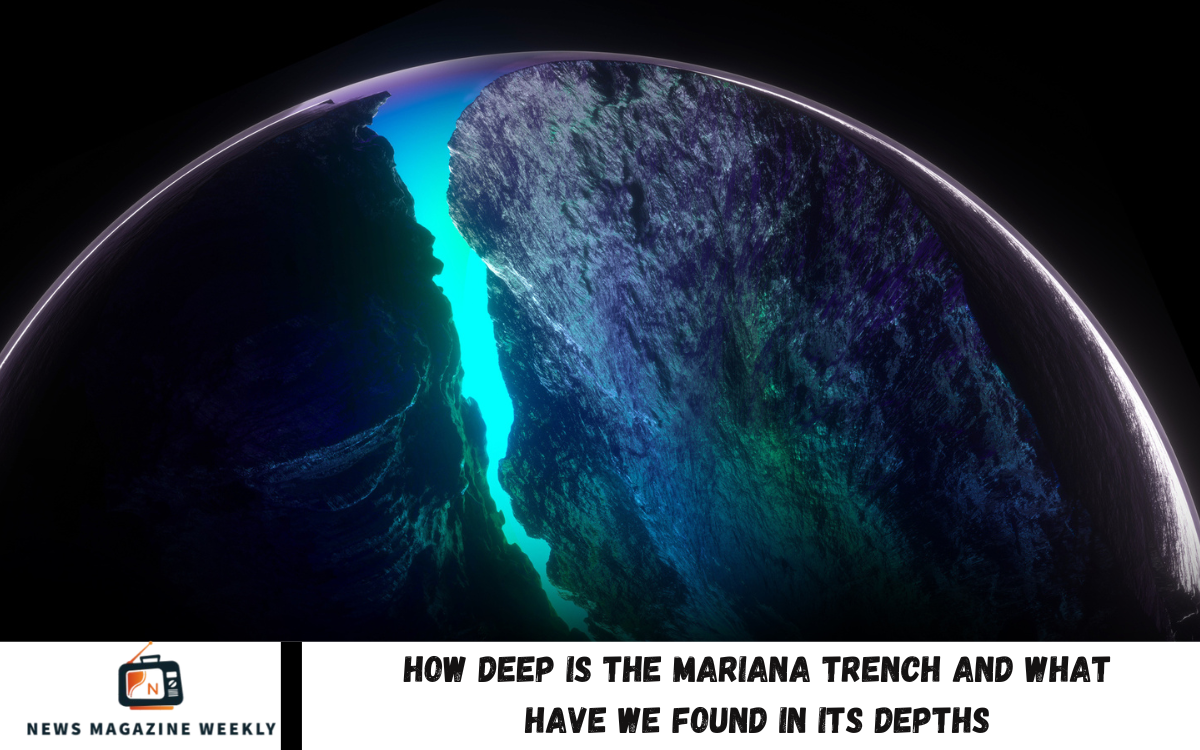The Mariana Trench, located in the western Pacific Ocean, is the deepest part of Earth’s oceans, reaching a staggering depth of about 36,000 feet (nearly 7 miles). Known as the Challenger Deep, this mysterious abyss remains one of the most extreme and least explored areas on our planet. Despite its vast depth, the trench continues to captivate scientists and explorers alike, as it harbors some of the most unique.
Several deep-sea expeditions have ventured into its dark, crushing depths, uncovering remarkable discoveries. Some of the most surprising finds include previously unknown species of fish, jellyfish, and shrimp that have adapted to extreme pressure, cold, and lack of sunlight. Researchers have also found strange, bioluminescent creatures that glow in the pitch-black waters, relying on light to communicate or attract prey.
The trench has yielded valuable information about Earth’s geology. Its study has provided insight into plate tectonics, the Earth’s crust, and how these processes shape our planet. While much of the Mariana Trench remains unexplored, it continues to be a source of scientific fascination, offering a glimpse into the planet’s most extreme environments.
How Deep is the Mariana Trench?
The deepest part of Earth’s oceans. It reaches a maximum depth of approximately 36,000 feet (about 10,994 meters), though some measurements suggest it could be even more profound, with estimates ranging up to 36,070 feet (nearly 11,000 meters). The trench is situated east of the Mariana Islands, from which it takes its name.
At its deepest point, known as the Challenger Deep, the trench plunges into a region of extreme darkness and pressure. To put it into perspective, if Mount Everest, the highest mountain on Earth at 29,032 feet (8,848 meters), were placed at the bottom of the Mariana Trench, its peak would still be over a mile underwater.
The Mariana Trench is formed by the subduction of the Pacific Plate beneath the smaller Mariana Plate. Due to its extreme conditions, the trench is not just a geographic marvel but a site of immense scientific interest, making it a challenging and fascinating area for exploration.
The Challenger Deep: The Deepest Point on Earth
The Challenger Deep is the deepest known point on Earth, located within the Mariana Trench in the western Pacific Ocean. It reaches a mind-boggling depth of about 36,000 feet (around 10,994 meters), which is nearly seven miles below the ocean’s surface.
Named after the British HMS Challenger expedition in the 1870s, which first mapped the trench, Challenger Deep is a place of immense geological and scientific interest. The trench itself was formed by the subduction of the Pacific Plate beneath the Mariana Plate, creating this deep, narrow chasm in the ocean floor. The area remains largely unexplored due to the extreme conditions—extreme pressure, near-freezing temperatures, and complete darkness.
Despite these challenges, the Challenger Deep has been visited by a few daring explorers. Notably, in 2012, filmmaker James Cameron made a solo journey to the bottom of the trench in a specially designed submersible. His expedition marked a significant milestone in deep-sea exploration.
Read Also: Where is the Lost City of Atlantis — and Does it Even Exist
Bizarre Creatures of the Mariana Trench
The Mariana Trench, with its extreme depth and harsh conditions, is home to some of the most bizarre and fascinating creatures on Earth. The creatures found in this abyssal environment have evolved unique adaptations to survive the crushing pressure, freezing temperatures, and complete darkness. Here are some of the most astonishing and otherworldly creatures discovered in the trench:
Anglerfish
- One of the most iconic creatures of the deep sea, the anglerfish is found in the pitch-black waters of the trench. Its large, toothy mouth is perfect for snatching unsuspecting prey that gets too close.
Giant Amoebas (Xenophyophores)
- These giant single-celled organisms thrive in the depths of the Mariana Trench. They can grow to be several inches across and have a fascinating ability to create elaborate, mineral-rich structures around their bodies to protect themselves from the harsh environment.
Snailfish
- The snailfish, a translucent, jelly-like fish, has been observed at depths of over 26,000 feet in the trench. Despite their delicate appearance, they are tough survivors, adapted to withstand the extreme pressure of the deep ocean. Their gelatinous bodies help them cope with the crushing pressure.
Vampire Squid
- The vampire squid, with its eerie red eyes and dark cloak-like webbing, is neither a squid nor an octopus but a unique species of cephalopod. It thrives in the oxygen-deprived depths of the trench, where it survives by feeding on detritus that sinks from the surface.
Deep-Sea Jellyfish
- The deep-sea jellyfish, often seen pulsating through the dark waters, have delicate, translucent bodies that can survive the immense pressures of the trench. Some species even have bioluminescent properties, glowing faintly in the inky blackness.
These bizarre creatures are just a few examples of the extraordinary adaptations life has developed to thrive in the Mariana Trench’s dark, high-pressure environment. Scientists believe there may still be many remote parts of the world.
What We’ve Learned from the Mariana Trench?
Exploring the Mariana Trench has provided scientists with valuable insights into the Earth’s geology, oceanography, and biology. Despite its harsh conditions, this mysterious abyss offers life on Earth and the dynamics of our planet’s systems. Here are some of the key lessons we’ve learned from the Mariana Trench:
Extreme Adaptations of Life
From bioluminescent organisms that glow in the pitch-black waters to fish and jellyfish that can withstand crushing pressures, life in the Mariana Trench has revealed the immense resilience of living beings. These adaptations give scientists new perspectives on how and potentially even on other planets with similar harsh conditions.
Understanding Plate Tectonics
The Mariana Trench provides crucial information about plate tectonics. The Pacific Plate beneath the smaller Mariana Plate creates a deep depression in the ocean floor. By studying the trench, scientists have been able to better understand how Earth’s plates move, how subduction zones operate, and how this process contributes to deep oceanic trenches.
Deep-Sea Ecosystems
Research in the trench has helped uncover how deep-sea ecosystems function. Despite the lack of sunlight and extreme pressures, life thrives in the trench, feeding on food that sinks from the surface and on the chemical energy produced by underwater volcanic vents. This has shifted our understanding of the potential for life in other extreme environments, such as hydrothermal vents on other planets or moons.
Environmental Impact of Human Activity
Some studies have shown that even the most remote parts of the ocean, like the Mariana Trench, are not immune to human impact. Marine pollution, including plastic waste, has been found at incredible depths, raising concerns about how pollutants travel through the ocean and affect even the most distant ecosystems. This has prompted a renewed focus on the importance of ocean conservation.
Technological Advancements
Exploring the Mariana Trench has driven technological innovation. Deep-sea submersibles, remotely operated vehicles (ROVs), and specially designed pressure-resistant equipment have been developed to withstand the immense pressure at such depths. These advancements have allowed for more detailed exploration of the trench and opened doors for further ocean exploration in other remote parts of the world’s oceans.
Insights into Earth’s Early History
The unique geology of the Mariana Trench, along with the materials found in its depths, can offer clues about the early Earth. The study of deep-sea minerals and the geological processes in subduction zones can provide insights into the formation of the Earth’s crust and its evolution over millions of years.
The Mariana Trench continues to be an invaluable natural laboratory, offering knowledge that expands our scientific horizons and deepens Earth.
Frequently Asked Questions
What scientific discoveries have been made in the Mariana Trench?
Exploration of the trench has led to discoveries about unique ecosystems, deep-sea life, and geological processes like plate tectonics and subduction. It has also provided insights into other planets.
Has anyone reached the bottom of the Mariana Trench?
Yes, in 2012, filmmaker James Cameron made a solo journey to the bottom of the trench in a specially designed submersible. This was the first solo expedition to Challenger Deep, though other expeditions have also reached the trench’s depths.
What does the Mariana Trench tell us about plate tectonics?
The trench is a subduction zone where one tectonic plate is pushed beneath another. Studying the trench helps scientists understand how Earth’s plates move, how earthquakes occur, and how ocean trenches form.
What impact has human activity had on the Mariana Trench?
Even the deepest parts of the ocean, like the Mariana Trench, are affected by pollution, mainly plastic waste. Research has shown that human-made materials, including microplastics, have been found in the trench, raising concerns about environmental degradation.
Why is the Mariana Trench so difficult to explore?
The trench is located at an extreme depth, where the pressure is more than 1,000 times that of sea level, making it a challenging environment for exploration. The lack of light and the harsh conditions require specialized, high-tech submersibles and ROVs to reach the depths.
Conclusion
The Mariana Trench, with its staggering depth and otherworldly conditions, continues to be one of the most mysterious and fascinating parts of our planet. As the deepest point on Earth, it offers unique insights into the limits of life, the complexity of Earth’s geology, and the vastness of unexplored frontiers beneath the ocean’s surface.

